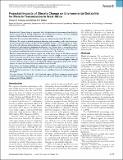Projected Impacts of Climate Change on Environmental Suitability for Malaria Transmission in West Africa
Author(s)
Yamana, Teresa K.; Eltahir, Elfatih A. B.
DownloadEltahir_Projected impacts.pdf (2.330Mb)
PUBLISHER_POLICY
Publisher Policy
Article is made available in accordance with the publisher's policy and may be subject to US copyright law. Please refer to the publisher's site for terms of use.
Terms of use
Metadata
Show full item recordAbstract
Background: Climate change is expected to affect the distribution of environmental suitability for malaria transmission by altering temperature and rainfall patterns; however, the local and global impacts of climate change on malaria transmission are uncertain.
Objective: We assessed the effect of climate change on malaria transmission in West Africa.
Methods: We coupled a detailed mechanistic hydrology and entomology model with climate projections from general circulation models (GCMs) to predict changes in vectorial capacity, an indication of the risk of human malaria infections, resulting from changes in the availability of mosquito breeding sites and temperature-dependent development rates. Because there is strong disagreement in climate predictions from different GCMs, we focused on the GCM projections that produced the best and worst conditions for malaria transmission in each zone of the study area.
Results: Simulation-based estimates suggest that in the desert fringes of the Sahara, vectorial capacity would increase under the worst-case scenario, but not enough to sustain transmission. In the transitional zone of the Sahel, climate change is predicted to decrease vectorial capacity. In the wetter regions to the south, our estimates suggest an increase in vectorial capacity under all scenarios. However, because malaria is already highly endemic among human populations in these regions, we expect that changes in malaria incidence would be small.
Conclusion: Our findings highlight the importance of rainfall in shaping the impact of climate change on malaria transmission in future climates. Even under the GCM predictions most conducive to malaria transmission, we do not expect to see a significant increase in malaria prevalence in this region.
Date issued
2013-09Department
Massachusetts Institute of Technology. Department of Civil and Environmental Engineering; Parsons Laboratory for Environmental Science and Engineering (Massachusetts Institute of Technology)Journal
Environmental Health Perspectives
Publisher
Environmental Health Perspectives
Citation
Yamana, Teresa K., and Elfatih A.B. Eltahir. “Projected Impacts of Climate Change on Environmental Suitability for Malaria Transmission in West Africa.” Environmental Health Perspectives 121, no. 10 (September 16, 2013): 1179–1186.
Version: Final published version
ISSN
0091-6765
1552-9924